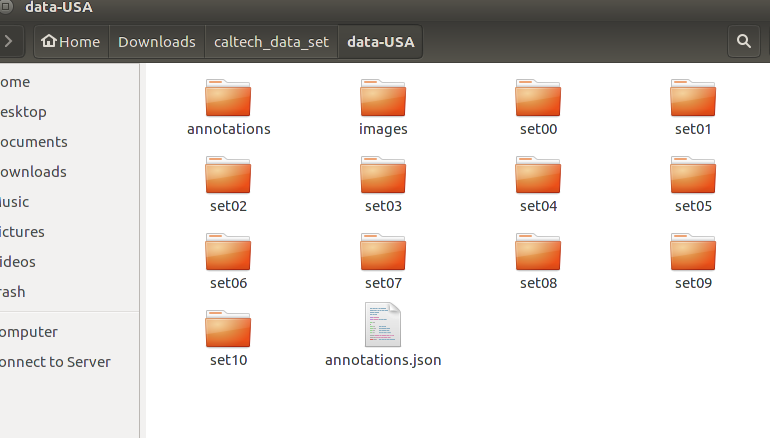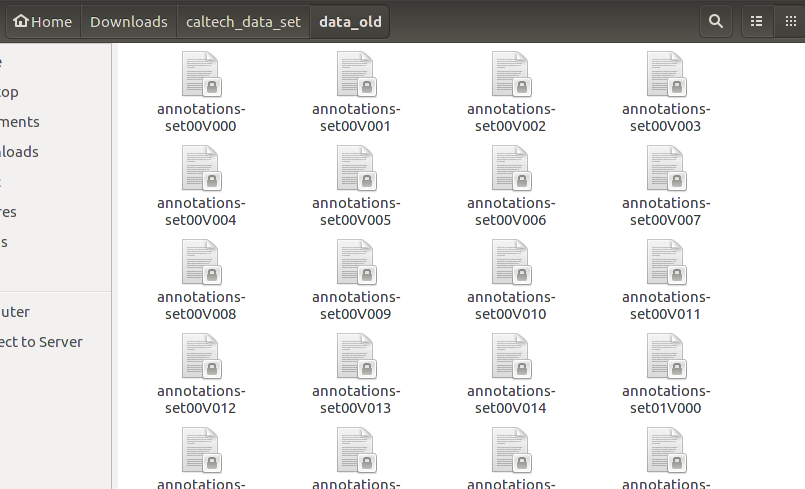将caltech数组集做成VOC格式
一、先下载caltech数据集
二、格式转换代码将 ".seq" 转换为 ".jpg" 文件 ( https://github.com/mitmul/caltech-pedestrian-dataset-converter.git)
#!/usr/bin/env python
# -*- coding: utf-8 -*-
import os
import glob
import cv2 as cv
def save_img(dname, fn, i, frame):
cv.imwrite('{}/{}_{}_{}.png'.format(
out_dir, os.path.basename(dname),
os.path.basename(fn).split('.')[0], i), frame)
out_dir = 'data/images'
if not os.path.exists(out_dir):
os.makedirs(out_dir)
for dname in sorted(glob.glob('data/set*')):
for fn in sorted(glob.glob('{}/*.seq'.format(dname))):
cap = cv.VideoCapture(fn)
i = 0
while True:
ret, frame = cap.read()
if not ret:
break
save_img(dname, fn, i, frame)
i += 1
print(fn)
三、将".vbb" 文件转化为 二进制文件文件(需要依赖code3.2.1)

maindir = '/home/user/Downloads/caltech_data_set/data-USA/';
subdir = dir( maindir );
for i = 1 : length( subdir )
if( isequal( subdir( i ).name, '.' )||...
isequal( subdir( i ).name, '..')||...
~subdir( i ).isdir)
continue;
end
% subdirpath = fullfile( maindir, subdir( i ).name, '' );
% dat = dir( subdirpath );
%
% for j = 1 : length( dat )
% datpath = fullfile( maindir, subdir( i ).name, dat( j ).name);
% fid = fopen( datpath );
%
% end
if((subdir(i).isdir && isequal(subdir(i).name(1:3), 'set')))
tmp = fullfile(maindir, subdir(i).name);
ssdir = dir(tmp);
for j = 1 : length( ssdir )
if(ssdir(j).isdir)
if( isequal( ssdir( j ).name, '.' )||...
isequal( ssdir( j ).name, '..')||...
~ssdir( j ).isdir)
continue;
end
vName1 = fullfile(subdir(i).name, ssdir(j).name);
fprintf(vName1);
fnm = [subdir(i).name , ssdir(j).name];
fprintf(fnm);
vbb_to_txtt(vName1, fnm);
fprintf(vName1)
end
end
% vName1 = fullfile('set00', subdir(i).name);
% fprintf(vName1);
end
end
function vbb_to_txtt(vName, fnm)
% vName = 'set01/V000'
A = vbb( 'vbbLoad', [dbInfo '/annotations/' vName] );
path = '/home/user/Downloads/caltech_data_set/data/annotations';
%fnm = 'set01-V000.txt';
c=fopen([path '-' fnm],'w');
for i = 1:A.nFrame
iframe = A.objLists(1,i);
iframe_data = iframe{1,1};
n1length = length(iframe_data);
for j = 1:n1length
iframe_dataj = iframe_data(j);
if iframe_dataj.pos(1) ~= 0 %pos posv
fprintf(c,'%d %f %f %f %f\n', i, iframe_dataj.pos(1),iframe_dataj.pos(2),iframe_dataj.pos(3),iframe_dataj.pos(4));
end
end
end
fclose(c);
end
四、将生成二进制文件中的标注框写成VOC格式的XML文件
#!/usr/bin/env python
# coding:utf-8
#from xml.etree.ElementTree import Element, SubElement, tostring
from lxml.etree import Element, SubElement, tostring
import pprint
from xml.dom.minidom import parseString
import os
def mkdir(path):
import os
path = path.strip()
path = path.rstrip("\\")
isExists = os.path.exists(path)
if not isExists:
os.makedirs(path)
print path + 'ok'
return True
else:
print path + 'failed!'
return False
def generate_xml(file_info, obj):
node_root = Element('annotation')
node_folder = SubElement(node_root, 'folder')
node_folder.text = file_info[0]
node_filename = SubElement(node_root, 'filename')
node_filename.text = file_info[1]
node_size = SubElement(node_root, 'size')
node_width = SubElement(node_size, 'width')
node_width.text = '640'
node_height = SubElement(node_size, 'height')
node_height.text = '480'
node_depth = SubElement(node_size, 'depth')
node_depth.text = '3'
for obj_i in obj:
print obj_i
node_object = SubElement(node_root, 'object')
node_name = SubElement(node_object, 'name')
#node_name.text = 'mouse'
node_name.text = 'person'
node_bndbox = SubElement(node_object, 'bndbox')
node_xmin = SubElement(node_bndbox, 'xmin')
#node_xmin.text = '99'
node_xmin.text = obj_i['xmin']
node_ymin = SubElement(node_bndbox, 'ymin')
#node_ymin.text = '358'
node_ymin.text = obj_i['ymin']
node_xmax = SubElement(node_bndbox, 'xmax')
#node_xmax.text = '135'
node_xmax.text = obj_i['xmax']
node_ymax = SubElement(node_bndbox, 'ymax')
#node_ymax.text = '375'
node_ymax.text = obj_i['ymax']
xml = tostring(node_root, pretty_print=True) #格式化显示,该换行的换行
dom = parseString(xml)
file_root = '/home/user/Downloads/caltech_data_set/data_test/'
file_name = file_root + file_info[0];
mkdir (file_name)
fw = open(file_name+"/"+file_info[1].split('.')[0]+".xml", 'a+')
fw.write(xml)
print "xml _ ok"
fw.close()
#for debug
#print xml
def printPath(level, path):
global allFileNum
'''''
打印一个目录下的所有文件夹和文件
'''
# 所有文件夹,第一个字段是次目录的级别
dirList = []
# 所有文件
fileList = []
# 返回一个列表,其中包含在目录条目的名称(google翻译)
files = os.listdir(path)
# 先添加目录级别
dirList.append(str(level))
for f in files:
if(os.path.isdir(path + '/' + f)):
# 排除隐藏文件夹。因为隐藏文件夹过多
if(f[0] == '.'):
pass
else:
# 添加非隐藏文件夹
dirList.append(f)
if(os.path.isfile(path + '/' + f)):
# 添加文件
fileList.append(f)
# 当一个标志使用,文件夹列表第一个级别不打印
i_dl = 0
for dl in dirList:
if(i_dl == 0):
i_dl = i_dl + 1
else:
# 打印至控制台,不是第一个的目录
print '-' * (int(dirList[0])), dl
# 打印目录下的所有文件夹和文件,目录级别+1
printPath((int(dirList[0]) + 1), path + '/' + dl)
print fileList
for fl in fileList:
# 打印文件
#print '-' * (int(dirList[0])), fl
# 随便计算一下有多少个文件
#allFileNum = allFileNum + 1
"""
操作文件进行读写
"""
print fl[12:17],fl[17:21]
file_info = []
file_info.append(fl[12:17]+'/'+fl[17:21])
print file_info
print path
file_name = path+"/"+fl
fw = open(file_name, 'r');
line_content = fw.readlines()
fw.close()
print line_content
tmp = -1
obj = []
con_len = len(line_content)
try:
string = line_content[0].split(" ")
tmp = int(string[0])
except Exception:
continue
file_info.append(str(tmp) + '.jpg')
xmin = str(int(float(string[1])))
ymin = str(int(float(string[2])))
xmax = str(int(float(string[1]) + float(string[3])))
ymax = str(int(float(string[2]) + float(string[4])))
dict1 = {}
dict1["xmin"] = xmin
dict1["ymin"] = ymin
dict1["xmax"] = xmax
dict1["ymax"] = ymax
obj.append(dict1)
for con_i in xrange(1, con_len):
string = line_content[con_i].split(" ")
tmp1 = int(string[0])
if tmp == tmp1:
xmin = str(int(float(string[1])))
ymin = str(int(float(string[2])))
xmax = str(int(float(string[1]) + float(string[3])))
ymax = str(int(float(string[2]) + float(string[4])))
dict1 = {}
dict1["xmin"] = xmin
dict1["ymin"] = ymin
dict1["xmax"] = xmax
dict1["ymax"] = ymax
obj.append(dict1)
elif tmp1 > 0:
generate_xml(file_info, obj)
obj = []
tmp = tmp1
file_info[1] = str(tmp1) + ".jpg"
xmin = str(int(float(string[1])))
ymin = str(int(float(string[2])))
xmax = str(int(float(string[1]) + float(string[3])))
ymax = str(int(float(string[2]) + float(string[4])))
dict1 = {}
dict1["xmin"] = xmin
dict1["ymin"] = ymin
dict1["xmax"] = xmax
dict1["ymax"] = ymax
obj.append(dict1)
continue
def read_annotations_generate_fileinfo_obj(file_path):
pass
if __name__=="__main__":
#
# file_info = ['set00/V000', '1.jpg']
#
# obj = []
# obj1 = {"xmin":"1", "ymin":"1", "xmax":"5", "ymax":"5"}
# obj2 = {"xmin":"2", "ymin":"2", "xmax":"6", "ymax":"6"}
# obj.append(obj1)
# obj.append(obj2)
#
# generate_xml(file_info, obj)
#
printPath(1, "/home/user/Downloads/caltech_data_set/data_old")
五、使用脚本,利用xml文件,生成train.txt trainval.txt test.txt 等文件

import os
import random
def folder_struct(level, path):
global allFileNum
dirList = []
fileList = []
files = os.listdir(path)
dirList.append(str(level))
for f in files:
if(os.path.isdir(path + '/' + f)):
if f[0] != '.':
dirList.append(f)
if (os.path.isfile(path + '/' + f)):
fileList.append(f)
i_dl = 0
for dl in dirList:
if i_dl == 0:
i_dl = i_dl + 1
else:
#print '-' * (int(dirList[0])), dl
folder_struct((int(dirList[0]) + 1), path+'/'+dl)
print dirList
# print fileList
# print dirList
for fl in fileList:
#print fl[12:17], fl[17:21]
file_info = (fl[12:17] + '/' + fl[17:21])
print file_info
generate_txt(file_info)
pass
def generate_txt(xml_folder):
trainval_percent = 0.66
train_percent = 0.5
folder_root = '/home/user/Desktop/VOC/'
xmlfilepath = folder_root + 'Annotations/'+xml_folder
txtsavepath = folder_root + 'ImageSets/Main'
try:
total_xml = os.listdir(xmlfilepath)
#print total_xml
num = len(total_xml)
#print num
list = range(num)
tv = int(num * trainval_percent)
tr = int(tv * train_percent)
trainval = random.sample(list, tv)
train = random.sample(trainval, tr)
ftrainval = open(folder_root + 'ImageSets/Main/trainval.txt', 'aw')
ftest = open(folder_root + 'ImageSets/Main/test.txt' , 'aw')
ftrain = open(folder_root + 'ImageSets/Main/train.txt' , 'aw')
fval = open(folder_root + 'ImageSets/Main/val.txt' , 'aw')
folder_name = xmlfilepath[-10:] + '/'
print folder_name
for i in list:
name = folder_name + total_xml[i][:-4] + '\n'
if i in trainval:
ftrainval.write(name)
if i in train:
ftrain.write(name)
else:
fval.write(name)
else:
ftest.write(name)
ftrainval.close()
ftrain.close()
fval.close()
ftest.close()
except Exception:
pass
#用来便利所有文件夹名的,没有用遍历文件夹名的方法,而是用一开始生成的注释文件的名字去遍历文件夹名。。。
folder_struct(1, "/home/user/Downloads/caltech_data_set/data_old")
在具体训练的时候,需要用0-5作为训练集,然后用6-10作为测试集
在跑的过程中,可能会有标注越界的问题,在voc_eval.py 和pascal_voc.py中进行更改就好了。推荐博客




 浙公网安备 33010602011771号
浙公网安备 33010602011771号